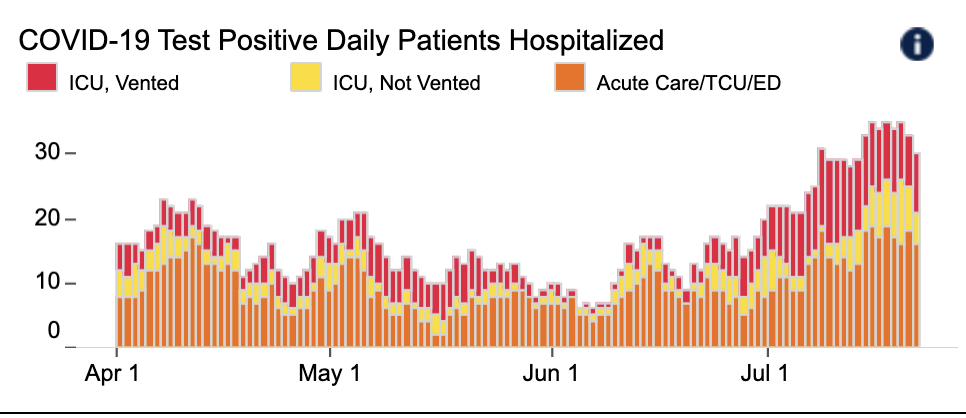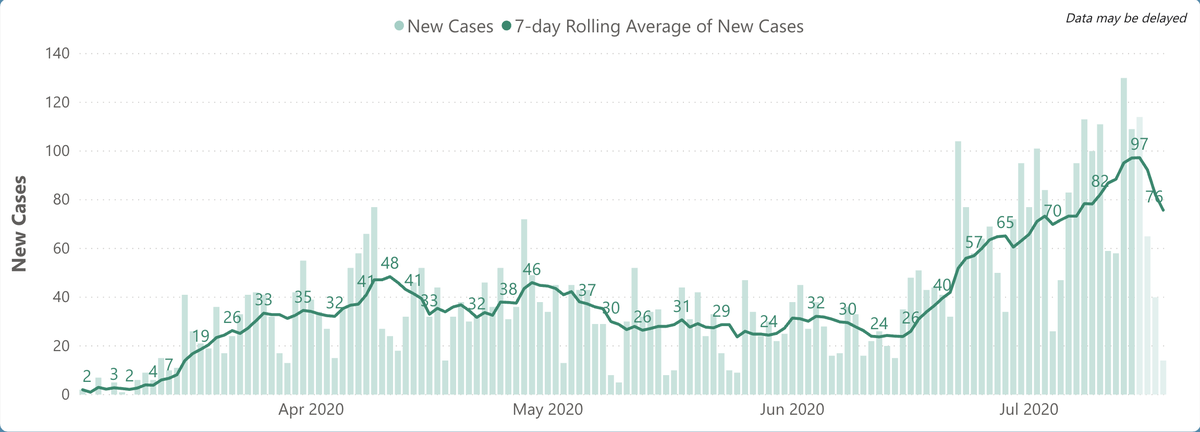1/ Covid ( @UCSF) Chronicles, Day 126
This isn’t normally my long-thread day, but I started on hospital wards today so this’ll be my biggie this week. I’ll also tweet Grand Rounds Thurs – we’ll discuss surges in the south & west, w/ speakers from Miami, Atlanta, Houston & @UCSF.
This isn’t normally my long-thread day, but I started on hospital wards today so this’ll be my biggie this week. I’ll also tweet Grand Rounds Thurs – we’ll discuss surges in the south & west, w/ speakers from Miami, Atlanta, Houston & @UCSF.
2/ No big changes in # 's today. @UCSF: 30 pts, 9 vents (Fig L). In SF, cases down a bit (R); city’s test + rate only 3% (vs CA 7.2%, U.S. 8.5%). 99 pts in hospitals. Overall, pretty stable.
We hit 1000 deaths in a day today in U.S., 1st time in July. So many were preventable.
We hit 1000 deaths in a day today in U.S., 1st time in July. So many were preventable.
3/ Today's topic: I was asked yesterday when life might “return to normal.” It’s a complex question, w/ many knowns, lots of known-unknowns, & some unknown-unknowns. But I’ll give it my best shot. Since I’m human (and thus want my old life back) I might be biased toward optimism.
4/ 1st question: what would allow us to get to "normal?” One way to think about this is: is there another infection that causes sickness/death at levels that we tolerate? (Behavioral economists & pollsters call this a “revealed preference.”)
The answer of course is yes: flu.
The answer of course is yes: flu.
5/ Let’s get 1 thing out of the way: Covid wasn’t “like the flu” in March, & it still isn’t. But even a moderately effective vaccine plus partly effective medications could make it so. When might we reach these goals? My guess: about a yr from now (Yes, that passes for optimism.)
6/ Another thing: chronic mask-wearing & distancing are NOT my idea of normal. We need to do both now to achieve some semblance of normalcy, but they're decidedly not a normal life. My normal: no or minimal masks, open restaurants & bars, ballparks w/fans & theaters w/audiences.
7/ Young folks can get very sick from Covid, but most don’t. We push them to stay safe mostly to prevent spread to vulnerable people (older/co-morbidities). If vulnerables were protected, the fact that some young people couldn’t or won’t get vaccinated wouldn’t be as concerning.
8/ What would “like the flu” mean? Per @CDCgov: in 2010-19, avg of ~30M Americans had influenza each yr, & flu led to avg of ~37,000 deaths/yr – an infection-fatality rate (IFR) of 0.12%. https://tinyurl.com/yzbcu3lm We’ve tolerated that level of illness/death from flu for a century.
9/ Contrast w/ Covid: since March we’ve had 3.9M confirmed cases & 140,000 deaths in the U.S., for an IFR of 3.6%. Taking all the cases (asymptomatic & minimal symptoms w/o Covid test) into account, the real IFR is likely ~0.6%, or about 5x that of the flu https://tinyurl.com/ycbetske
10/ So, to get the fatality rate down to flu-like levels would require that we slash Covid fatalities by a factor of 5, via some combination of fewer symptomatic cases and a lower chance that a symptomatic patient will go on to die. How might that happen?
11/ First principle: we don’t need a 100%-effective vaccine injected into 330M deltoid muscles (in U.S. alone). Thank God, since it’s fanciful to believe that we can have a vaccine that’s 100% effective, 100% distributed (by next summer), & that 100% of Americans agree to take.
12/ How are we doing in our vaccine path? Yesterday was a banner day, w/ promising reports from 3 companies https://tinyurl.com/y66slgt6 ; Oxford vaccine led to both antibodies & cellular immune response https://tinyurl.com/y4wf2uo5 . This is on the heels of hopeful @moderna_tx news last wk.
13/ While every vaccine article sounds an obligatory cautionary note, to date we’ve checked every box on the path to a safe and effective vaccine. Most experts I talk to predict one or more FDA-approvable vaccines (>50% effective, no show-stopping side effects) by early 2021.
14/ True, we don’t know how long immunity will last, but we can solve that later if needed. If we can get to an effective vaccine that lasts for a year or 2, over time we should be able to discover strategies (additional boosters, new meds) to address (potential) waning immunity.
15/ So…. I’m going to put my nickel down on this optimistic scenario: that we’ll have one, and likely several, vaccines that have been proven to be reasonably effective and safe by January 2021.
If only that were the finish line.
If only that were the finish line.
16/ The investments in manufacturing & distribution should pay off, but it’s still inconceivable that we’ll be able to get vaccines to 330M people in 3-6 months. In the 2009 swine flu epidemic, we managed to vaccinate about 1 in 4 Americans over 6 months https://tinyurl.com/y55q2sth
17/ So we’ll need to prioritize. First up will likely be the 55M people >age 65, and 6-8M healthcare workers. (How to prioritize among people under 65 w/ “chronic diseases” will be a toughie.) Vaccinating 80-100M vulnerable people (plus clinicians) might be do-able by mid-21.
18/ If we can protect vulnerable folks with an effective vaccine (w/ the less vulnerable waiting for 6-12 mths), that may do the trick. (Of course, the vulnerable people may also be least likely to develop immunity to a vaccine. That could be an Achilles’ heel – time will tell.)
19/ Why might that be enough? Once we vaccinate a large fraction of high-risk patients, even a fair number of unvaccinated people out there won’t pose nearly as much threat. By definition, they have a lower chance of getting sick & dying than those who received the vaccine first.
20/ And we'll probably have better meds by then too. Since March, we’ve discovered 2 modestly effective Covid meds (remdesivir & dexamethasone). It seems likely that we’ll find others by next summer – perhaps even a pill that prevent pts from getting very ill in the first place.
21/ Moreover, we know that hospitals that aren't overrun w/ Covid have lower mortality rates. If we’ve gotten a fairly effective vaccine into most high-risk people, hospitals are less likely to be overwhelmed – another factor that may lower the mortality rate to flu-like levels.
22/ All of these factors – vaccination of most vulnerable people, 1 or 2 additional effective meds, hospitals/ICUs that aren’t overwhelmed – could combine to bring the toll of Covid down to something that resembles that of the flu.
That, I think, could mean a return to normal.
That, I think, could mean a return to normal.
23/ Worries? Today’s @nytimes The Daily was terrifying https://tinyurl.com/yy5xy98o On top of anti-vaxxer fringe, it seems many worry that a vaccine developed this fast won’t be safe. Plus many don’t trust Trump. Whatever the reason, if people won’t take the vaccine, all bets are off.
24/ Note that even if high-risk people do get vaccinated, there will still be Covid cases, & even some mini-outbreaks. Obviously, that’s not ideal, and we should hope for better. But the point is that – even with flu-like levels of illness & death – we may still achieve “normal.”
25/ While the “like the flu” mantra has been a partisan canard, it can also be a goal, one we may well reach in the next 9-12 months. Hope is not a strategy, as the saying goes. But it is hope, which is more than we’ve had for a while.
Back Thursday for Grand Rounds. Stay safe.
Back Thursday for Grand Rounds. Stay safe.

 Read on Twitter
Read on Twitter



